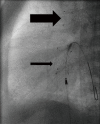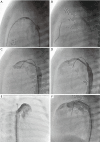Acute therapy of newborns with critical congenital heart disease
- PMID: 31161078
- PMCID: PMC6514285
- DOI: 10.21037/tp.2019.04.06
Acute therapy of newborns with critical congenital heart disease
Abstract
Critical congenital heart disease (cCHD) is the most common reason for acute cardiac failure in the neonatal period. cCHD, defined by systemic low cardiac output (LCO) and requiring surgery or catheter-based intervention in the first year of life, has an incidence of approximately 15% of CHD and is responsible for up to 25% fatalities of newborn infants. Clinical deterioration develops in most cases due to rapid closure of the ductus arteriosus (DA). Early diagnosis and immediate treatment determinate beneficial outcome. Critical CHD can be classified in duct-dependent systemic flow, duct-dependent pulmonary flow and transposition of the great arteries. The latter two manifest themselves in oxygen resistant cyanosis, whereas CHD with duct-dependent systemic flow may present itself with cardiogenic shock, which can be difficult to differentiate from other causes of shock such as sepsis. Besides prostaglandin therapy for reopening the arterial duct, a balanced parallel pulmonary and systemic circulation should be a therapeutic goal. In CHD with duct-dependent systemic flow a decrease of pulmonary resistance should be avoided; therefore inadequate oxygen therapy, hyperventilation and alkalosis due to excessive treatment of acidosis, should be averted. Volume therapy should be performed carefully. In CHD with duct-dependent pulmonary flow, pulmonary resistance can be decreased, in case of poor pulmonary flow systemic resistance should be increased, mild alkalosis is recommended. Intense volume therapy is in most cases necessary, except if a restrictive atrial communication is present. In addition to intensive care measures, an arsenal of catheter- and surgery-based procedures need to be hold available as back-up for emergency procedures. Transcatheter interventions are nowadays decisive. Atrial-septostomy was the first and still the most utilized high-urgency procedure; DA-stenting is used in prostaglandin-refractory duct stenosis. In the presence of critical aortic valve stenosis, palliation consists of balloon valvuloplasty. In critical aortic coarctation with myocardial failure and no response to prostaglandin, palliative balloon angioplasty may be the method of choice as bridging for corrective surgery.
Keywords: Newborns; critical congenital heart disease (cCHD); fetal circulation; postnatal management; transcatheter therapy.
Conflict of interest statement
Conflicts of Interest: The authors have no conflicts of interest to declare.
Figures




References
Publication types
LinkOut - more resources
Full Text Sources
Medical
